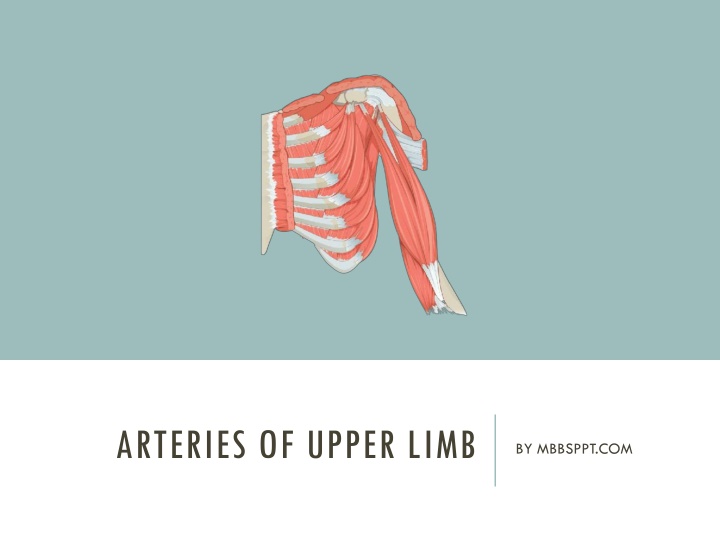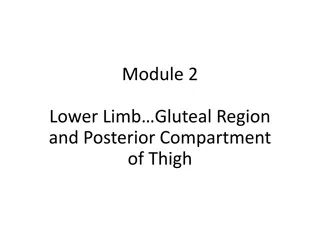
Upper Limb Arteries: Anatomy and Pathway Overview
Explore the detailed pathway of the arteries in the upper limb, starting from the axillary artery and transitioning into the brachial, radial, and ulnar arteries. Understand how these arteries supply blood to different regions of the arm and hand, forming vital arches for circulation. Discover the significance of each artery in maintaining proper blood flow to the upper limb structures and digits.
Download Presentation

Please find below an Image/Link to download the presentation.
The content on the website is provided AS IS for your information and personal use only. It may not be sold, licensed, or shared on other websites without obtaining consent from the author. If you encounter any issues during the download, it is possible that the publisher has removed the file from their server.
You are allowed to download the files provided on this website for personal or commercial use, subject to the condition that they are used lawfully. All files are the property of their respective owners.
The content on the website is provided AS IS for your information and personal use only. It may not be sold, licensed, or shared on other websites without obtaining consent from the author.
E N D
Presentation Transcript
ARTERIES OF UPPER LIMB BY MBBSPPT.COM
AXILLARY ARTERY The arterial supply to the upper limb begins in the chest as the subclavian artery. When the subclavian arteries cross the lateral edge of the 1st rib, they enter the axilla, and are called axillary arteries. The axillary artery passes through the axilla, just underneath the pectoralis minor muscle, enclosed in the axillary sheath. At the level of the humeral surgical neck, the posterior and anterior circumflex humeral arteries arise. They circle posteriorly around the humerus to supply the shoulder region. The largest branch of the axillary artery also arises here the subscapular artery. The axillary artery becomes the brachial artery at the level of the teres major muscle. MBBSPPT.COM 2
BRACHIAL ARTERY When the axillary artery reaches the lower border of the teres major, it becomes the brachial artery. The brachial artery is the main source of blood for the arm. MBBSPPT.COM 5
Immediately distal to the teres major, the brachial artery gives rise to the profunda brachii the deep artery of the arm. It travels along the posterior surface of the humerus, running in the radial groove. It supplies structures in the posterior aspect of the arm e.g. the triceps brachii, and terminates by contributing to a network of vessels at the elbow joint. The brachial artery descends down the arm immediately posterior to the median nerve. As it crosses the cubital fossa, underneath the brachialis muscle, the brachial artery terminates by bifurcating into the radial and ulnar arteries. MBBSPPT.COM 6
RADIAL AND ULNAR ARTERY In the distal region of the cubital fossa, the brachial artery bifurcates into the radial artery and the ulnar artery. The radial artery supplies the posterior aspect of the forearm and the ulnar artery supplies the anterior aspect. The two arteries anastomose in the hand, by forming two arches, the superficial palmar arch, and the deep palmar arch. MBBSPPT.COM 7
In the hand, the ulnar and radial arteries interconnect to form two arches, from which branches to the digits emerge. Radial artery contributes mainly to supply of the thumb and the lateral side of the index finger. Ulnar artery contributes mainly to the supply of the rest of the digits, and the medial side of the index finger. MBBSPPT.COM 8
The ulnar artery moves into the hand anteriorly to the flexor retinaculum, and laterally to the ulnar nerve. In the hand, it divides into two branches, the superficial palmar arch, and the deep palmar branch. From the superficial palmar arch, common palmar digital arteries arise, supplying the digits. The superficial palmar arch then anastomoses with a branch of the radial artery. The superficial palmar arch is found anteriorly to the flexor tendons in the hand, deep to the palmar aponeurosis. The radial artery enters the hand dorsally, crossing the floor of the anatomical snuffbox. It turns medially and moves between the heads of the adductor pollicis. The radial artery then anastomoses with the deep palmar branch of the ulnar artery, forming the deep palmar arch, which gives rise to five arteries supplying the digits. MBBSPPT.COM 9
AXILLARY ARTERY ANEURYSM An aneurysm is dilation of a blood vessel to more than twice its original size. Although rare, axillary artery aneurysms can occur as a result of atherosclerosis, thoracic outlet syndrome, or trauma. The dilated portion of the axillary artery can compress the brachial plexus, producing neurological symptoms such as paraesthesia and muscle weakness. The definitive treatment of an axillary artery aneurysm is surgical, and involves removing the aneurysm and reconstructing the vessel wall using a graft. MBBSPPT.COM 10
OCCLUSION OR LACERATION OF THE BRACHIAL ARTERY The arm has relatively good anastomotic supply which protects it from temporary or partial occlusion of the brachial artery. However, if the artery is completely blocked, or severed, it is a medical emergency. The resulting ischemia of the forearm can cause necrosis and paralysis of the muscles in the forearm. The affected muscles are replaced to some degree by scar tissue, and shorten considerably. This can cause a characteristic flexion deformity, caused Volkmann s contracture. MBBSPPT.COM 11






















